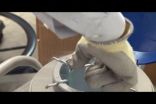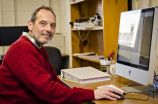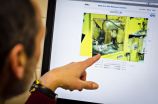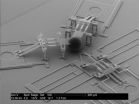(Press-News.org) COLUMBIA, Mo. – The human body is full of proteins called enzymes that help nearly every function in the body. Scientists have been studying enzymes for decades in order to learn how they work and how to create better drugs and medical treatments for many ailments. Now, University of Missouri researchers have completed a 3-D map of an enzyme called Proline utilization A (PutA). PutA facilitates metabolism by adding oxygen to molecules. John Tanner, a professor in the MU Department of Biochemistry, says mapping this enzyme will give researchers a better understanding of its function, which could help drug manufacturers create more effective drugs.
"PutA is actually two enzymes fused together to make its processing more efficient," Tanner said. "Now that we have an understanding about how PutA is constructed, we can study exactly how it works. Some dangerous bacteria, such as h. pylori, which infect stomach tissue, utilize the PutA enzyme to grow. Discovering the structure of this enzyme will provide valuable insight into how this protein functions and could provide blueprints for designing drugs that inhibit or increase certain protein functions, which would make those drugs more effective."
Tanner conducted his study by using a process called protein crystallography. This process involves growing microscopic crystals made of PutA enzymes. Tanner then shipped the protein crystals to Berkeley, Calif., where they were exposed to a high-powered X-ray device called a "beamline." (The University of Missouri is a founding member of the Molecular Biology Consortium (MBC), which operates the beamline in California.) The beamline device is one of only five in the world and is the size of a football field.
VIDEO:
University of Missouri researchers have completed a 3-D map of an enzyme called Proline utilization A (PutA). PutA facilitates metabolism by adding oxygen to molecules. John Tanner, a professor in...
Click here for more information.
The beamline captures X-rays, focuses them on protein crystals, and records the beams that reflect or "diffract" off the crystals. Tanner decoded the diffraction patterns from his crystals to understand the precise arrangement of the atoms in the protein and created a 3-D "map" of the PutA enzyme.
"This entire project would not be possible without our access to the MBC beamline," Tanner said. "The X-ray device we have on campus has only a fraction of the power of the beamline, and we would not be able to complete this complex mapping project without such a high-powered X-ray device."
Tanner says the next step in his research is to explore the functions of each individual structure of the PutA enzyme to better understand how the enzyme works. The Department of Biochemistry is in the MU College of Food, Agriculture and Natural Resources and the MU School of Medicine. Tanner is also a professor in the Department of Chemistry in the MU College of Arts and Science.
INFORMATION:
Tanner's study was published in the Proceedings of the National Academies of Science.
3-D 'map' of enzyme completed by MU scientists could lead to more effective drugs
Enzyme map created by using a high-powered X-ray device
2014-05-13
ELSE PRESS RELEASES FROM THIS DATE:
Achieving patient-centered care across the spectrum
2014-05-13
HANOVER, NH – Providing patient-centered care consistently in clinical practice requires practitioners who are able to recognize that different clinical situations require different approaches and are skilled enough to adapt.
Across the range of health-care problems, patient-centered care has been found to be associated with improved patient outcomes, including improved self-management, patient satisfaction, and medication adherence, and some studies have found evidence for improved clinical outcomes. Data from surveys and research indicate that clinicians often do not ...
Obsessive-compulsive disorder questionnaire may give clues to other mental health problems
2014-05-13
A shortened version of a questionnaire used by psychologists to assess risk factors for obsessive-compulsive disorder also may help determine the risk of depression and anxiety, according to a Baylor University study.
The revision may be a good fit for assessing the risk of mental health issues stemming from certain beliefs — such as seeing threats as greater than they are and feeling that things are not right unless they are perfect. Such dysfunctional beliefs are central to obsessive-compulsive disorder (OCD), said researcher Thomas Fergus, Ph.D., assistant professor ...
Women's empowerment and Olympic success
2014-05-13
ALLENDALE, Mich. — New research shows that nations with greater women's empowerment win more medals and send more athletes to the Summer Olympics. The effect of women's empowerment held for both men and women, although it was stronger for female athletes, according to a study by Grand Valley State University researchers. The findings were published in April 2014 in the Journal of Sports Economics.
The research, led by Aaron Lowen, associate professor of economics at Grand Valley State, provides evidence for the popular but previously untested hypothesis that women's empowerment ...
Fossil palm beetles 'hind-cast' 50-million-year-old winters
2014-05-13
Fifty-million-year-old fossil beetles that fed only on palm seeds are giving Simon Fraser University biologists Bruce Archibald and Rolf Mathewes new information about ancient climates.
According to their research, published online this week in The Proceedings of the National Academy of Sciences, these fossil beetles indicate that during a period of global warming in the geological past, there were mild, frost-free winters extended even in the uplands of ancient western North America.
Working with co-authors Geoffrey Morse of the University of San Diego, California, ...
Letting it go: Take responsibility, make amends and forgive yourself
2014-05-13
Forgiving ourselves for hurting another is easier if we first make amends — thus giving our inner selves a "moral OK," according to Baylor University psychology researchers.
The research, published in The Journal of Positive Psychology, is significant because previous studies show that the inability to self-forgive can be a factor in depression, anxiety and a weakened immune system, researchers said.
"One of the barriers people face in forgiving themselves appears to be that people feel morally obligated to hang on to those feelings. They feel they deserve to feel bad. ...
UT Dallas team creates flexible electronics that change shape inside body
2014-05-13
Researchers from The University of Texas at Dallas and the University of Tokyo have created electronic devices that become soft when implanted inside the body and can deploy to grip 3-D objects, such as large tissues, nerves and blood vessels.
These biologically adaptive, flexible transistors might one day help doctors learn more about what is happening inside the body, and stimulate the body for treatments.
The research, available online and in an upcoming print issue of Advanced Materials, is one of the first demonstrations of transistors that can change shape and ...
Radiation from early universe found key to answer major questions in physics
2014-05-13
Astrophysicists at UC San Diego have measured the minute gravitational distortions in polarized radiation from the early universe and discovered that these ancient microwaves can provide an important cosmological test of Einstein's theory of general relativity. These measurements have the potential to narrow down the estimates for the mass of ghostly subatomic particles known as neutrinos.
The radiation could even provide physicists with clues to another outstanding problem about our universe: how the invisible "dark matter" and "dark energy," which has been undetectable ...
Smart drugs pose special risks to the developing brain of young people
2014-05-13
Over a million American students misuse prescription drugs or take illegal stimulants to increase their attention span, memory, and capacity to stay awake. Such "smart drugs" become more and more popular due to peer pressure, stricter academic requirements, and the tight job market. But young people who misuse them risk long-term impairments to brain function, warn Kimberly Urban at the University of Delaware and Wen-Jun Gao at Drexel University College of Medicine, USA, in a NIH-funded review published in the open-access journal Frontiers in Systems Neuroscience.
The ...
The physics of ocean undertow
2014-05-13
WASHINGTON D.C. May 13, 2014 -- People standing on a beach often feel the water tugging the sand away from under their feet. This is the undertow, the current that pulls water back into the ocean after a wave breaks on the beach.
Large storms produce strong undertows that can strip beaches of sand. By predicting how undertows interact with shorelines, researchers can build sand dunes and engineer other soft solutions to create more robust and sustainable beaches.
"Formulation of the Undertow Using Linear Wave Theory," a new paper in the journal Physics of Fluids, clears ...
MEMS nanoinjector for genetic modification of cells
2014-05-13
WASHINGTON D.C. May 13, 2014 -- The ability to transfer a gene or DNA sequence from one animal into the genome of another plays a critical role in a wide range of medical research—including cancer, Alzheimer's disease, and diabetes.
But the traditional method of transferring genetic material into a new cell, called "microinjection," has a serious downside. It involves using a small glass pipette to pump a solution containing DNA into the nucleus of an egg cell, but the extra fluid can cause the cell to swell and destroy it—resulting in a 25 to 40 percent cell death rate.
Now, ...
LAST 30 PRESS RELEASES:
The Ceramic Society of Japan’s Oxoate Ceramics Research Association launches new international book project
Heart-brain connection: international study reveals the role of the vagus nerve in keeping the heart young
Researchers identify Rb1 as a predictive biomarker for a new therapeutic strategy in some breast cancers
Survey reveals ethical gaps slowing AI adoption in pediatric surgery
Stimulant ADHD medications work differently than thought
AI overestimates how smart people are, according to HSE economists
HSE researchers create genome-wide map of quadruplexes
Scientists boost cell "powerhouses" to burn more calories
Automatic label checking: The missing step in making reliable medical AI
Low daily alcohol intake linked to 50% heightened mouth cancer risk in India
American Meteorological Society announces Rick Spinrad as 2026 President-Elect
Biomass-based carbon capture spotlighted in newly released global climate webinar recording
Illuminating invisible nano pollutants: advanced bioimaging tracks the full journey of emerging nanoscale contaminants in living systems
How does age affect recovery from spinal cord injury?
Novel AI tool offers prognosis for patients with head and neck cancer
Fathers’ microplastic exposure tied to their children’s metabolic problems
Research validates laboratory model for studying high-grade serous ovarian cancer
SIR 2026 delivers transformative breakthroughs in minimally invasive medicine to improve patient care
Stem Cell Reports most downloaded papers of 2025 highlight the breadth and impact of stem cell research
Oxford-led study estimates NHS spends around 3% of its primary and secondary care budget on the health impacts of heat and cold in England
A researcher’s long quest leads to a smart composite breakthrough
Urban wild bees act as “microbial sensors” of city health.
New study finds where you live affects recovery after a hip fracture
Forecasting the impact of fully automated vehicle adoption on US road traffic injuries
Alcohol-related hospitalizations from 2016 to 2022
Semaglutide and hospitalizations in patients with obesity and established cardiovascular disease
Researchers ‘listen in’ to embryo-mother interactions during implantation using a culture system replicating the womb lining
How changing your diet could help save the world
How to make AI truly scalable and reliable for real-time traffic assignment?
Beyond fragmented markets: A new framework for efficient and stable ride-pooling
[Press-News.org] 3-D 'map' of enzyme completed by MU scientists could lead to more effective drugsEnzyme map created by using a high-powered X-ray device





